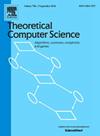A new fast root-finder for black box polynomials
IF 0.9
4区 计算机科学
Q3 COMPUTER SCIENCE, THEORY & METHODS
引用次数: 0
Abstract
Univariate polynomial root-finding has been studied for four millennia and very intensively in the last decades. Our black box root-finder involves no coefficients and works for a black box polynomial, defined by an oracle (that is, black box subroutine) for its evaluation. Such root-finders have various benefits, e.g., are particularly efficient where a polynomial can be evaluated fast, say, is the sum of a small number of shifted monomials . With incorporation of a fast algorithm by the first author for compression of a disc on the complex plane without losing roots, our root-finder approximates all d complex zeros of a dth degree polynomial (aka roots of equation ) by using near-optimal Las Vegas expected number of bit-operations,1 that is, the root-finder is expected to run almost as fast as one accesses the coefficients with a precision required for the solution within a prescribed error bound. The only other known near-optimal polynomial root-finder was presented by the first author at ACM STOC 1995. It is quite involved and has never been implemented, while already in its initial implementation our new root-finder competed with user's choice package of root-finding subroutines MPSolve, according to extensive numerical experiments with standard test polynomials. Furthermore we readily extend our black box root-finder to approximation of the eigenvalues of a matrix in record expected bit operation time, while the root-finder of STOC 1995, using the coefficients of , does not support such extension.
求助全文
约1分钟内获得全文
求助全文
来源期刊

Theoretical Computer Science
工程技术-计算机:理论方法
CiteScore
2.60
自引率
18.20%
发文量
471
审稿时长
12.6 months
期刊介绍:
Theoretical Computer Science is mathematical and abstract in spirit, but it derives its motivation from practical and everyday computation. Its aim is to understand the nature of computation and, as a consequence of this understanding, provide more efficient methodologies. All papers introducing or studying mathematical, logic and formal concepts and methods are welcome, provided that their motivation is clearly drawn from the field of computing.
 求助内容:
求助内容: 应助结果提醒方式:
应助结果提醒方式:


